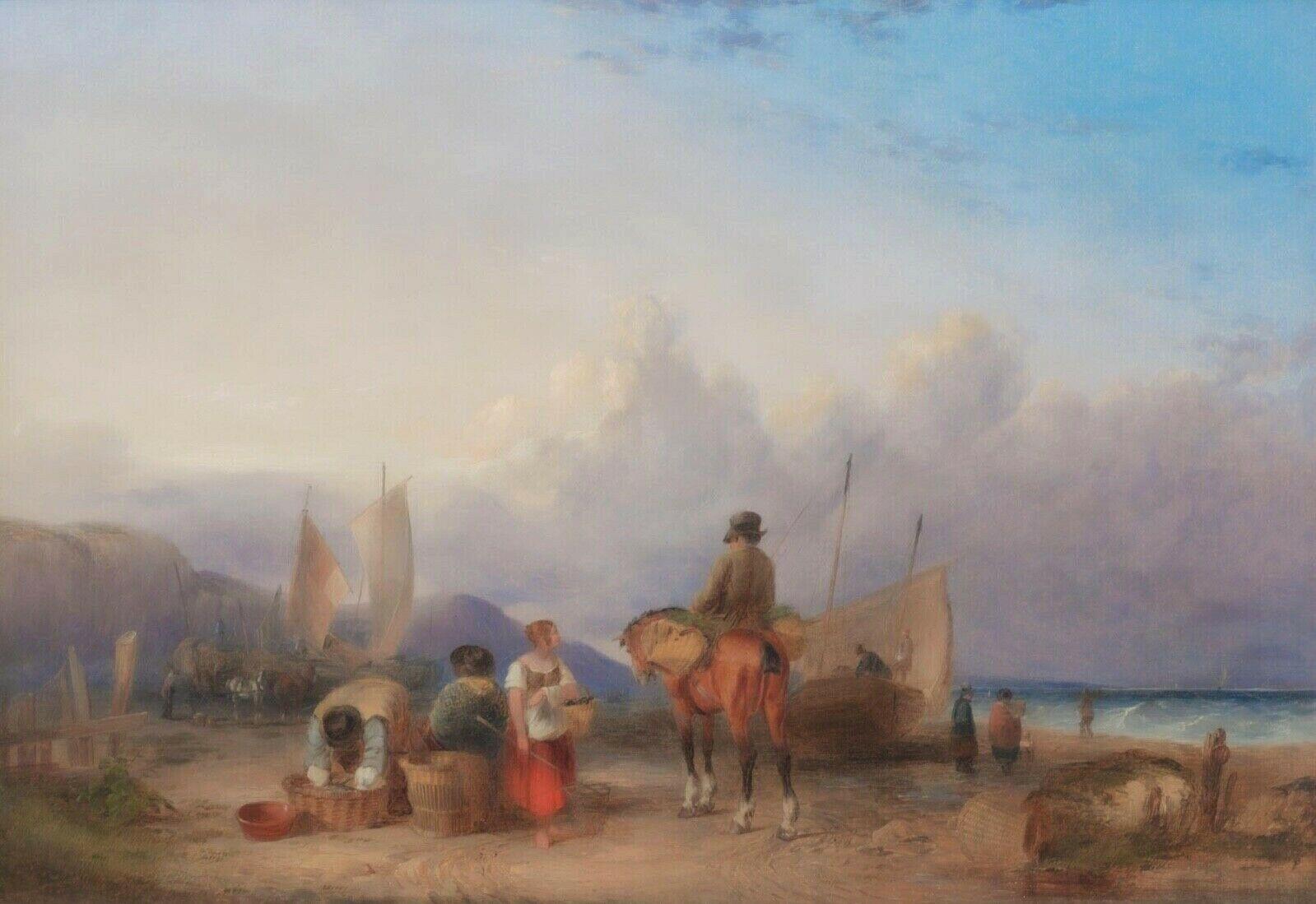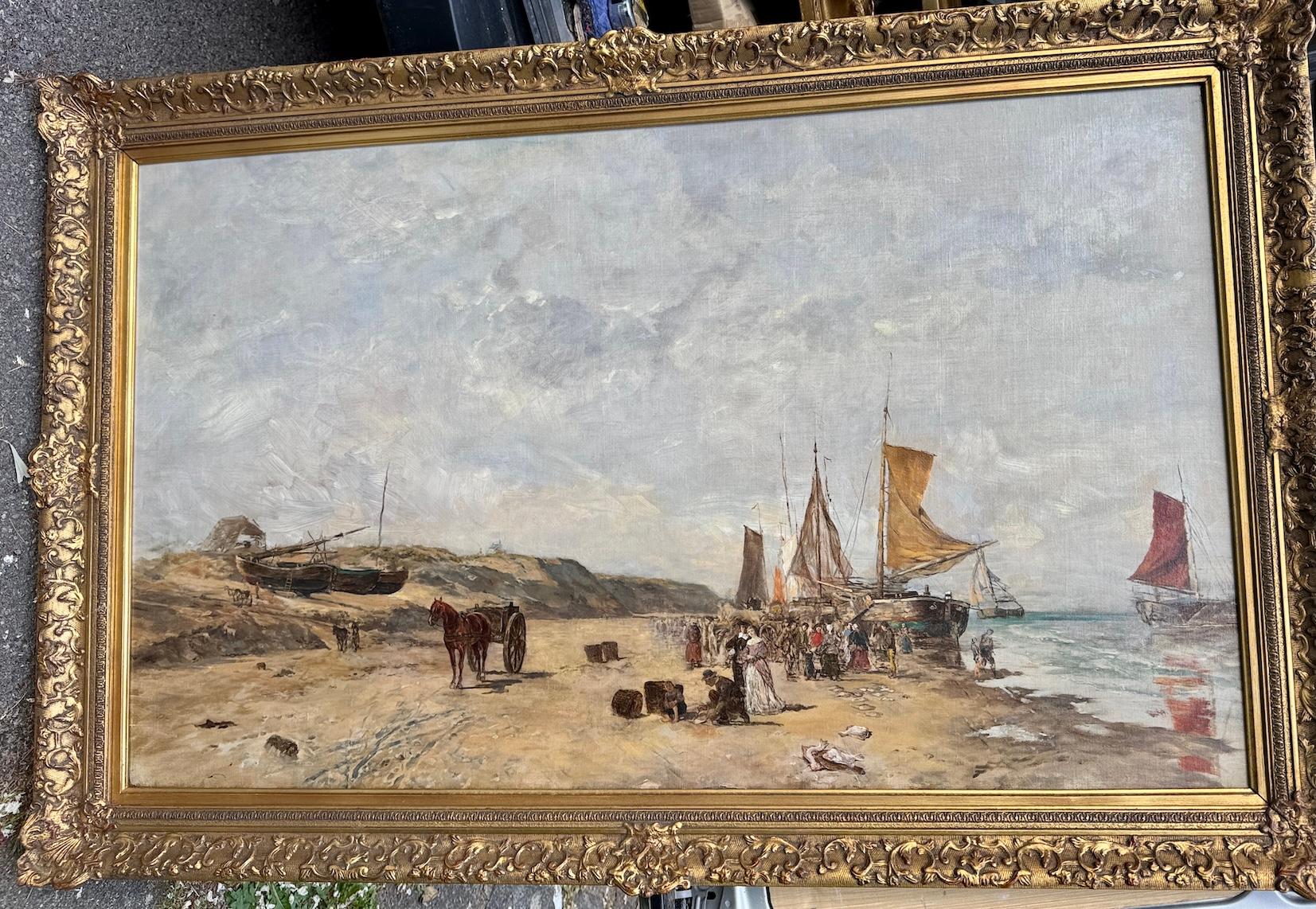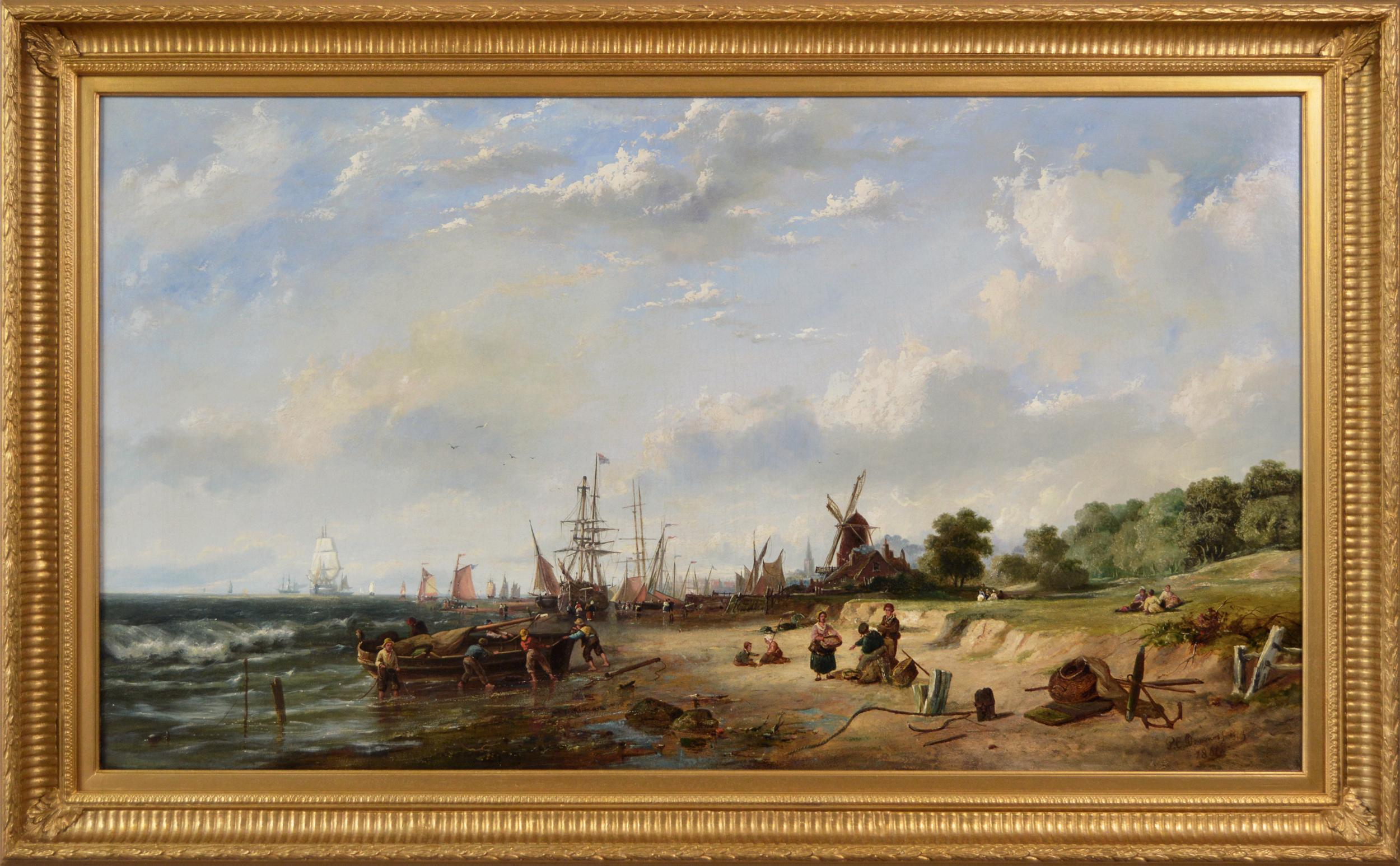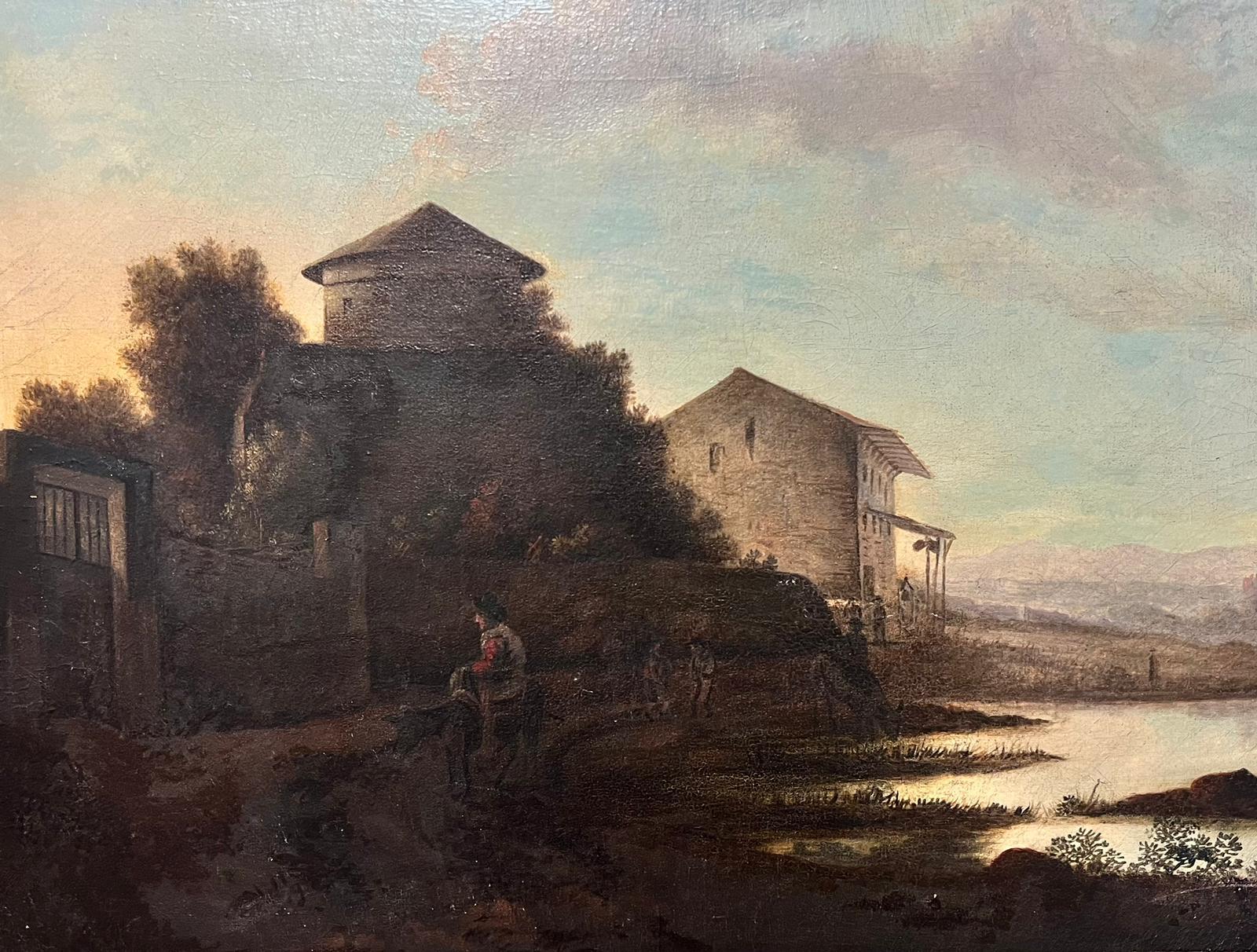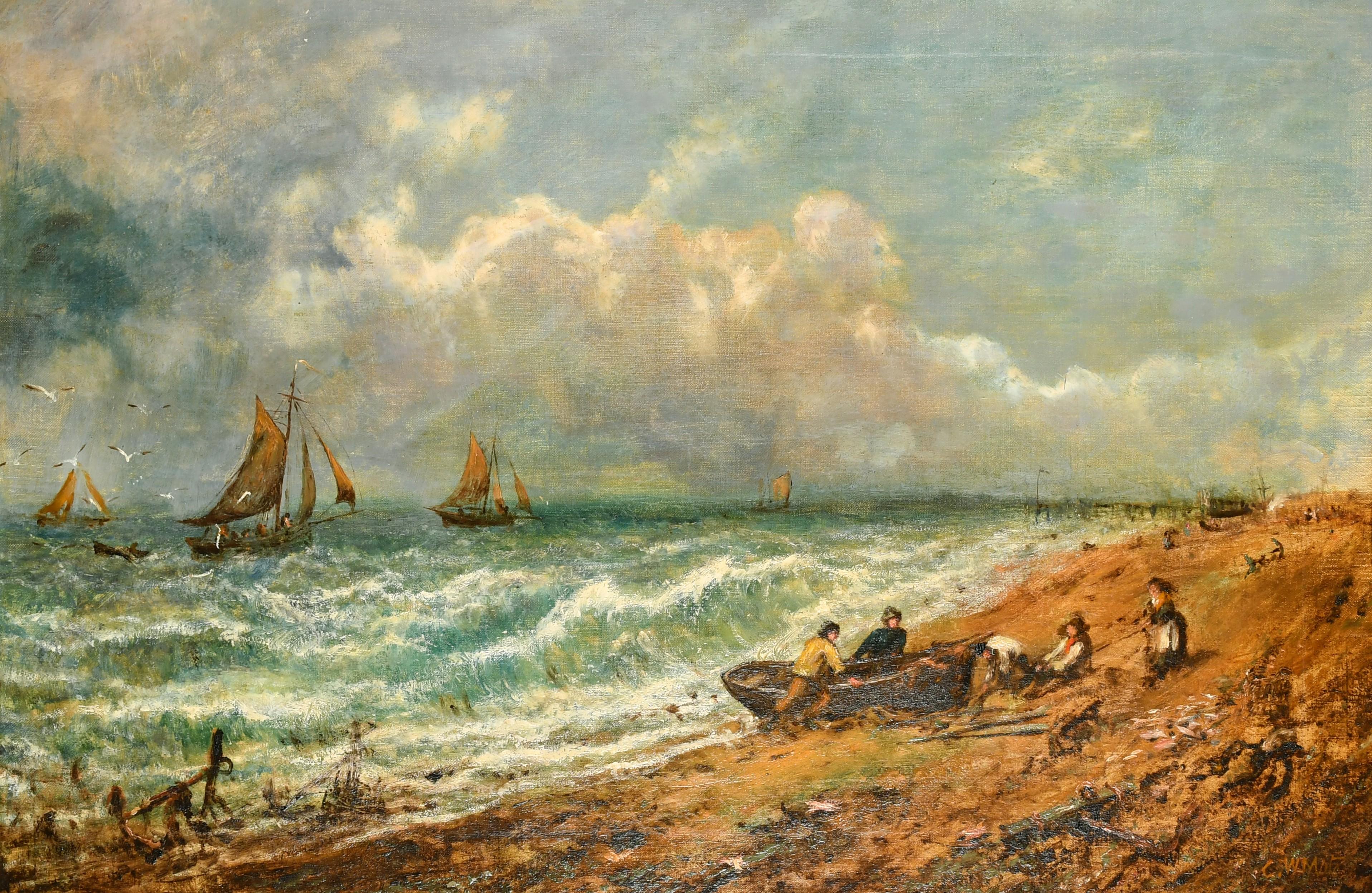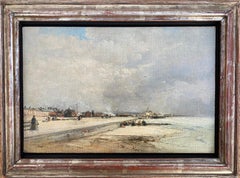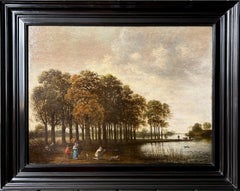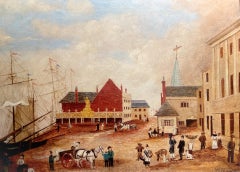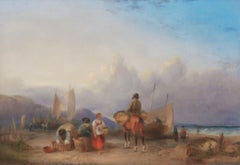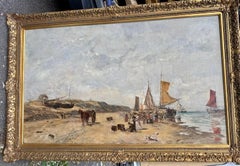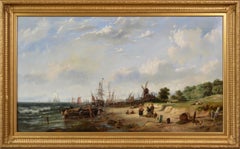Items Similar to Figures on the Beach at Scheveningen
Want more images or videos?
Request additional images or videos from the seller
1 of 11
Jan Van GoyenFigures on the Beach at Scheveningen1642
1642
$165,001.54
£121,429
€141,901.82
CA$230,834.02
A$252,643.92
CHF 131,325.55
MX$3,040,656.60
NOK 1,650,969.59
SEK 1,548,660.88
DKK 1,059,914.77
About the Item
Jan van Goyen
1596-1656
Figures on the Beach at Scheveningen
Oil on panel, monogrammed and dated '1642' lower left
Image size: 13 x 21 ¾ inches (33 x 55.5 cm)
Ebonised Dutch frame
Provenance
Private Estate
Sotheby's, October 27 1989, lot 69
Christie's, July 7 1972, lot 82
Collection of J.F. van Abbe, 1940
Exhibitions
Oude Kunst in Brabants Bezit, Tilburg, 1948, no.35
Literature
Hans-Ulrich. Beck: Jan van Goyen 1596-1656. Ein Oeuvreverzeichnis in zwei Bänden, Amsterdam 1973, vol. II & ,p. 422, no. 944.
Jan van Goyen is credited as one of the first artists to create the beach landscape, which is the subject matter of the above painting. He uses panorama to create the sense of a sweeping, dune-filled landscape, and dots a few figures in the foreground and background. These figures, picked out in vivid colours, remain in the lower half of the image - it is the cloudy, moody sky that dominates the image. Van Goyen’s ability to render the encompassing storm clouds and sandy dunes demonstrates his strong competency as a landscape artist.
Van Goyen was known to paint scenes of distinctly Dutch landscapes, such as this one that depicts people in 17th century Dutch clothing embracing the local trade of fishing. His typical monochromatic palette of grey and brown is also noticeable in this work, punctuated by brief splashes of muted colour in the clothing of the citizens. Therefore, this work is a beautiful example of the artistic practices and tendencies that Van Goyen is best remembered for.
Jan van Goyen
Jan Josephszoon van Goyen was born in Leiden in 1596, and studied art under multiple teachers, including Esaias van de Velde, Coenraet A van Schilperoort, Jan de Man, Willem Gerritsz, and Isaac van Swanenburgh. The influence of Van de Velde is evident in Van Goyen’s work, through his privileging of naturalism.
Van Goyen started his studio in his thirties at The Hague, rapidly producing landscape and cityscape works. Whilst these works did not sell for much, Van Goyen was clever with his production - by thinly applying inexpensive pigments, he could produce copious amounts of paintings that made up for their low selling cost. He received two major commissions, one for the Town Hall of The Hague and the other for the royal palace of Honselaersdijk. Van Goyen was a respected figure in the art scene in The Hague - he was the head of the Guild of St Luke, and Gerard ter Borch painted a portrait of him in the early 1650s. Van Goyen is credited as one of the artists who developed a new approach to landscape painting that focused on tonal palettes and local subject matters, which in turn is seen as the start of the golden age of Dutch landscape art.
Aside from his art, Van Goyen displayed a business-oriented mind and dabbled in tulip farming, art dealing, auctioneering and real estate - these endeavours were not fruitful, however, and left the artist in debt. In an attempt to resolve this debt, Van Goyen had to sell his collection of art and move to a smaller house, but finances were still thin for the artist. Upon his death in 1656, his widow was forced to sell their remaining art and furnishings to cover the remaining debt of 18,000 guilders.
Van Goyen’s studio taught pupils such as Adriaen van der Kabel, Nicolaes van Berchem, and Jan Steen - the latter of whom would become Van Goyen’s son-in-law. His high level of productivity and broad range of landscape subject matter had an undeniable effect on the next generation of Dutch landscape art. His work is in prominent collections such as the J Paul Getty Museum, the Kunsthistorisches Museum, the Hermitage, the Louvre, the Metropolitan Museum of Art and London’s National Gallery.
- Creator:Jan Van Goyen (1596 - 1656, Dutch)
- Creation Year:1642
- Dimensions:Height: 13 in (33.02 cm)Width: 21.75 in (55.25 cm)
- Medium:
- Period:
- Condition:
- Gallery Location:London, GB
- Reference Number:1stDibs: LU52416639072
About the Seller
5.0
Vetted Professional Seller
Every seller passes strict standards for authenticity and reliability
Established in 2007
1stDibs seller since 2014
85 sales on 1stDibs
Typical response time: 3 hours
- ShippingRetrieving quote...Shipping from: London, United Kingdom
- Return Policy
Authenticity Guarantee
In the unlikely event there’s an issue with an item’s authenticity, contact us within 1 year for a full refund. DetailsMoney-Back Guarantee
If your item is not as described, is damaged in transit, or does not arrive, contact us within 7 days for a full refund. Details24-Hour Cancellation
You have a 24-hour grace period in which to reconsider your purchase, with no questions asked.Vetted Professional Sellers
Our world-class sellers must adhere to strict standards for service and quality, maintaining the integrity of our listings.Price-Match Guarantee
If you find that a seller listed the same item for a lower price elsewhere, we’ll match it.Trusted Global Delivery
Our best-in-class carrier network provides specialized shipping options worldwide, including custom delivery.More From This Seller
View AllLittle Hampton - seascape - James Webb - oil sketch
By James Webb
Located in London, GB
James Webb
1825 - 1895
Littlehampton, Sussex
Oil on board, signed lower left
Image size: 8 x 12 inches
Contemporary silver gilt frame
This painting has on ...
Category
1860s Landscape Paintings
Materials
Oil
Heron Shoot in a Landscape
Located in London, GB
Joris Abrahamsz van der Haagen
Heron Shoot in a Landscape
1615-1669
Oil on oak panel, signed 'JAH' lower left
Image size: 16 x 21 inches (41 x 53 cm)
Dutch ebonised frame
Provenance...
Category
17th Century Old Masters Landscape Paintings
Materials
Oil, Panel, Oak
The Old Quay, Barnstaple, 19th Century Oil Landscape
Located in London, GB
Oil on board, signed 'W.H. Jones' bottom right
Image size: 8 1/2 x 11 1/2 inches (21.5 x 29.25 cm)
Framed
Inscribed on reverse 'The Old Quay, which ceased to exist after the coming ...
Category
1870s Landscape Paintings
Materials
Oil, Board
Gorleston on Sea, Norfolk, 20th Century British Artist, Seascape
By Frederick Donald Blake
Located in London, GB
Frederick Donald Blake RI, RMSI
1908–1997
Gorleston on Sea, Norfolk
Gouache, signed lower right
Image size: 6 x 16¼ inches (15 x 41 cm)
Hand made gilt frame
Category
Mid-20th Century Landscape Drawings and Watercolors
Materials
Gouache
General View of Tyre
By David Roberts
Located in London, GB
David Roberts RA
General View of Tyre
1796 - 1864
Subscription edition and First edition
Full plate: 69
Presented in an acid free mount
Available in original hand coloured subscript...
Category
1840s Realist Landscape Prints
Materials
Laid Paper, Lithograph
Open Seas, Late 19th Century
Located in London, GB
Oil on board
Image size: 14 3/4 x 11 3/4 inches (37.5 x 30 cm)
Contemporary hand made frame
A dramatic, and highly colourful, depiction of the crashing waves of the open seas.
The ...
Category
Late 19th Century English School Landscape Paintings
Materials
Oil, Board
You May Also Like
Fisherfolk On The Beach, 19th Century
By WILLIAM SHAYER SENIOR (1787-1879)
Located in Blackwater, GB
Fisherfolk On The Beach, 19th Century
by William SHAYER (1787-1879)
Fine Large 19th Century English scene with fisherfolk on the beach overlooking the coastline, oil on canvas. E...
Category
19th Century Portrait Paintings
Materials
Canvas, Oil
Beach See Water Hubertus Van Hove Signed Paint Oil on table 19th Century Flemish
Located in Riva del Garda, IT
Hubertus van Hove (The Hague, 1814 - Antwerp, 1865)
- Signed H Van Hove and dated 1839 (bottom left) -
Coastal landscape with the beach of Scheveningen
Oil on panel
62 x 80 cm. - Framed 84 x 102 cm.
Provenance: Sotheby's, London, 19th Century European Paintings, Watercolours 12.03.1989, lot 11 (see details in photos)
The fine coastal view presented here is a work signed and dated by the Dutch landscape painter Hubertus van Hove (The Hague, 1814 - Antwerp, 1865), son of Bartholomeus van Hove (1790-1880). The work exhibits excellent taste and quality of execution, displaying a tender feeling for nature, romantic in character, and a mastery of drawing and a delicacy of chiaroscuro and harmony that is truly astonishing.
Although his major production was concentrated in works depicting domestic scenes, he was also an excellent landscape painter, a master in the use of light that he was able to infuse into his works through quick and precise brushstrokes, creating lively compositions such as the one in the catalogue.
Here we see a glimpse of one of the most fascinating beaches in the Netherlands, just a few kilometres from the city of The Hague, overlooking the North Sea. As early as the 17th century, this area became a popular seaside resort for entertainment, strolling and fish-buying among the citizens of nearby The Hague.
We are on a bright day on a wide sandy beach populated by numerous people who have come to breathe in the fresh sea air and are engaged in various activities. In the foreground we see a well-dressed couple on horseback, probably on a trip to the seaside, accompanied by a servant and a horseman, observing the catch lying on the beach by a fishing family. Behind them a carriage has stopped, the wealthy passenger chats with another middle-class couple, while a servant protects them from the sun with an umbrella.
The space is mainly occupied by the sky, criss-crossed by a few clouds and lit by a pale sun; typical is the clear, gentle light that gives a great sense of tranquillity to the composition.
The Dutch were the first to think of the sea in a ''modern'' sense, as a place of recreation, and already in the 17th century the beach of Scheveningen, famous because it was also the subject of paintings by Vincent van Gogh, was a place of pastime and outdoor activity.
Many Flemish authors, first and foremost Adriaen van de Velde...
Category
1830s Impressionist Paintings
Materials
Oil
$14,555 Sale Price
20% Off
19th century Beach Landscape in Scheveningen, Holland with fishing boats, people
By Edward William Cooke
Located in Woodbury, CT
Edward William Cooke RA (1811–1880)
Dutch Beach at Scheveningen, oil on canvas, circa 1850
This sweeping coastal scene by Edward William Cooke, painted circa 1850, captures the bust...
Category
1850s Victorian Landscape Paintings
Materials
Canvas, Oil
19th Century seascape oil painting of fishing boats by a Dutch shore
By Pieter Cornelis Dommersen
Located in Nr Broadway, Worcestershire
Pieter Cornelis Dommersen
Dutch, (1833-1918)
Launching the Boat
Oil on canvas, signed & dated 1861
Image size: 23 inches x 41 inches
Size including frame: 29.75 inches x 47.75 inches
A beautifully painted marine scene of a boat being launched from a Dutch shore by Pieter Cornelis Dommersen. In the foreground, fishermen can be seen heaving a boat into the water as others look on. Beyond the beach, a number of ships are shown moored next to a windmill whilst further ships are depicted sailing around the harbour.
Pieter Cornelis Dommersen was born Pieter Cornelis Dommershuizen or Dommerhershuisen on 6 December, 1833 in Utrecht, Holland. Little is known about his father and he appears to have been brought up solely by his mother Cornelia into an artistic family. His younger brother was the artist Cornelis Christian...
Category
19th Century Victorian Landscape Paintings
Materials
Oil, Canvas
Antique Dutch Oil Painting Figures at Sunset by Coastal Estuary with Buildings
Located in Cirencester, Gloucestershire
A River Landscape With A Figure On A Donkey
1800's Dutch School
oil painting on canvas, framed
framed: 21 x 27 inches
canvas: 18 x 24 inches
provenance: private collection, England
...
Category
Early 19th Century Old Masters Landscape Paintings
Materials
Oil, Canvas
Large Victorian Oil Painting Fisherfolk on Windswept Beach Choppy Seas & Sky
By George William Mote
Located in Cirencester, Gloucestershire
A Beach Scene With Figures
George William Mote (1832-1909) British, signed
oil painting on canvas, framed
framed: 25 x 28 inches
canvas: 22 x 27 inches
provenance: private collectio...
Category
Mid-19th Century Victorian Landscape Paintings
Materials
Oil, Canvas
More Ways To Browse
Paintings On The Beach
Antique Kunst
De Maneer
Antique Beach Painting
Oil Painting By J Law
17th Century Painted Panels
17th Century Oil On Panel Portrait
17th Century Figures
Jan Van Goyen
Gerard Ter Borch
Portrait Paintings Women
8x8 Frame
Gottlieb Adolph
Oil Painting Ships At Sea
Paintings Of Boats
Roman School
Flowers Painting Modern
Blue Flower Paintings
